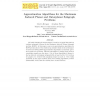37 search results - page 4 / 8 » Randomly coloring planar graphs with fewer colors than the m... |
DAM
2010
13 years 7 months ago
2010
A dynamic coloring of a graph is a proper coloring of its vertices such that every vertex of degree more than one has at least two neighbors with distinct colors. The least number...
DM
2010
13 years 7 months ago
2010
Let Mad(G) denote the maximum average degree (over all subgraphs) of G and let i(G) denote the injective chromatic number of G. We prove that if Mad(G) 5 2 , then i(G) + 1; sim...
JGT
2010
13 years 6 months ago
2010
Sufficient degree conditions for the existence of properly edge-colored cycles and paths in edge-colored graphs, multigraphs and random graphs are inverstigated. In particular, we...
PODC
2010
ACM
13 years 11 months ago
2010
ACM
Consider an n-vertex graph G = (V, E) of maximum degree ∆, and suppose that each vertex v ∈ V hosts a processor. The processors are allowed to communicate only with their neig...
JGAA
2007
13 years 7 months ago
2007
The task of finding the largest subset of vertices of a graph that induces a planar subgraph is known as the Maximum Induced Planar Subgraph problem (MIPS). In this paper, some n...

